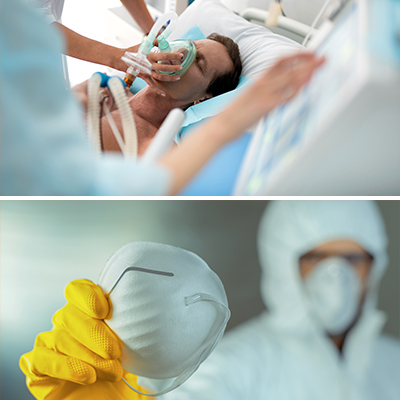To the untrained ear, the words “ventilator” and “respirator” sound basically the same. They’re both used to assist with breathing. In the last couple of years, with the spread of the novel coronavirus around the world leading to the current COVID-19 pandemic, these two terms are frequently used interchangeably. However, these two pieces of medical equipment are very different and have their own unique functions for patients and healthcare professionals. Keep reading to learn the difference between these two medical devices: ventilators vs respirators.
What is a Ventilator?
Ventilators were in the news daily during the first months of the COVID-19 pandemic. States struggled to find enough for the amount of COVID-19 patients in intensive care units (ICUs) needing oxygen.
A ventilator is used to help a patient breathe. It’s also known as a “breathing machine” or a “mechanical ventilator.” When your lungs are functioning normally, they transfer oxygen to your blood and expel carbon dioxide. Sometimes patients are too ill to breathe on their own and need assistance to breathe, referred to as artificial respiration. Without pressure, lung tissue can collapse. So, a ventilator keeps a patient oxygenated and the lung structures intact until the patient can be removed from the ventilator.
Modern ventilators are highly sophisticated machines that can deliver a customized mix of gasses for the patient. They are usually equipped with monitoring systems and can be programmed to alert medical staff according to certain parameters, such as gas flow, leaks, or battery failure. Since ventilators are considered “life critical systems”, they are designed with multiple redundancies in place so that no single failure will endanger the life of the patient. Even in a total loss of power, including the battery backup, a ventilator can still be operated by hand.
There are two different ways that a patient can be connected to a ventilator, invasive and non-invasive. Invasive connection can be achieved in two ways. The first is done through the process of intubation, which involves the insertion of an endotracheal tube (commonly called a breathing tube) down the patient’s trachea, or windpipe, and into the patient’s lungs. The second method is done using a procedure called a tracheostomy, which is a surgical opening into a patient’s airway to insert the breathing tube. Both of these procedures are performed while the patient is under sedation. The decision to intubate and place a patient on a ventilator has to be done quickly, because a low level of oxygen could result in a coma.
Non-Invasive Ventilation and CPAP
Non-invasive ventilation is for those who only require a ventilator at certain times. Chronic obstructive pulmonary disease (COPD) is the primary condition that requires non-invasive ventilation. The patient is not intubated, but instead wears a face mask. Non-invasive ventilation is different from continuous positive airway pressure (CPAP), because CPAP only delivers a single level of positive airway pressure through the breathing cycle, but does not deliver ventilation.
Breathing tubes are uncomfortable and prevent patients from eating or speaking normally. Nutrition has to be delivered through an IV tube inserted into a patient’s vein or a feeding tube through the stomach.
A doctor and respiratory therapist will decide the level of ventilator support a patient needs. Sometimes a patient’s respiratory system is functioning well enough for them to exhale on their own, and the ventilator is only there to assist with inhalation. In other cases, a ventilator is crucial for life support because the patient’s lungs need assistance.
Ventilators only provide breathing assistance and do not heal a patient’s lungs. They only give support while a patient’s immune system works to repair damage to the pulmonary system. When a patient has recovered enough, a doctor will test the patient’s breathing by switching off the ventilator, but still keeping the patient connected. If the patient can breathe on their own, the breathing tube will be removed.
What is a Respirator?
On the other hand, a respirator is a mask or wearable device that protects the wearer‘s lungs by filtering out harmful substances from the air. Individuals wear respirators to filter out smoke, fumes, dust, or pathogens. Usually, protective masks such as respirators were worn by firefighters, construction workers, or in other industries where they could be exposed to harmful chemicals or particles. Since the start of the COVID-19 pandemic, respirators are now seen on doctors and medical staff in normal practice.
The filters used in a respirator to remove foreign material from the air are assigned different letter and numerical ratings to indicate what is removed from the air, and how much.
Respirator Filter Ratings
Respirator filters are assigned one of three letters: N, R, or P. The letter rating demonstrates what the filter is removing from the air. N indicates that the filter is not oil resistant. R indicates that the filter is oil resistant. P is for filters that are oil-proof. In construction and heavy industries, many machines can put a fine mist or oil in the air.
The number ratings are 95, 99, and 100. Number 95 filters remove 95 percent of all particles from that air that are at least 0.3 microns in diameter. 99 filters remove 99 percent of particles that are at least 0.3 microns in diameter, and 100 removes 99.97 percent of particles that are at least 0.3 microns in diameter. 100 filters are considered HE or HEPA quality. For reference, the average human hair is about 70 microns in diameter.
When you hear “N95”, you know that the number and letter combination references a mask that is not oil resistant and filters out 95 percent of particles at least 0.3 microns in diameter. Note that the higher the number rating, the more difficult breathing becomes. The mask should always make a tight seal around the nose and mouth to keep potential contaminants out.
Respirator masks can cover the lower half of the face or the entire face. Depending on the occasion, full face protection is required because the wearer also needs eye protection. As a general rule, repeatedly taking off and reapplying the same respirator is not a good idea because the risk of contamination increases. Contamination can occur both by the wearer breathing contaminated air without the mask or by touching the mask with unwashed hands. Respirator masks should also be disposed of after 8 hours of use. Users should wash their hands thoroughly after touching a contaminated (or potentially contaminated) mask.
Two Essential Tools
Ventilators and respirators are both essential devices related to the breathing process, and there has been a tendency to mix the two terms. In practice, they are very different, not only in their usage but in how they assist the user. A ventilator helps the mechanical act of breathing, while a respirator performs filtration for the wearer to breathe uncontaminated air.
Here at Penn Care, we carry a full line of ventilator accessories and parts. We also stock personal protective equipment such as N95 masks. We’re the superior choice for all your medical equipment needs.



